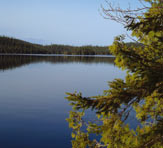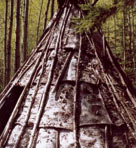  |
|
| |
Capacity-Building > What Capacity-Building Initiatives Exist? |
| |
The Forest Products Association of Canada has made available its internal programs database for the purposes of compiling this list. |
| |
|
| |
Go to: |
| |
Canada |
| |
British Columbia |
| |
Manitoba |
| |
Newfoundland and Labrador |
| |
New Brunswick |
| |
Education |
| |
International |
| |
|
| |
|
| |
Canada |
| |
First Nations Forestry Program |
| |
This is the only major federal program addressing needs in Aboriginal forestry, with a budget of $5 million per year. The federal funding objectives of this program frequently state the aim of "enhancing capacity". The 2005 mid-term evaluation of the FNFP is now available to the public. (Click here for French version.)
|
| |
The National Recruitment Steering Committee
|
| |
This is a multi-party group, convened by the Canadian Council of Forest Ministers and the Canadian Institute of Forestry, that is in the process of developing a strategy to increase the enrolment rate in professional and technical forestry schools across Canada. The main element of the strategy is a marketing campaign. This is not focused on Aboriginal youth, but they are recognized as a key component of the population of potential recruits. |
| |
Gathering Strength - Canada's Aboriginal Action Plan (Indian and Northern Affairs Canada) |
| |
The scope of this program is much broader than the forest or even natural resources sector, and capacity building is only one of the strategic approaches. However, funding is available to build capacity for negotiating and implementing governance, womens issues, statistical training, professional development in land, resources, and environment, and other activities. As of FY 2006-2007, the professional development component of this program has been moved under the new Professional and Institutional Development Program. |
| |
Building Environmental Aboriginal Human Resources (BEAHR) |
| |
Aboriginal Human Resources Development Council of Canada (AHRDCC) |
| |
First Nations Alliance 4 Land Management |
| |
|
| |
|
| |
British Columbia |
| |
Tl'azt'en Nation and University of Northern BC Community-University Research Alliance (CURA) |
| |
"The purpose of the Tl’azt’en Nation-UNBC CURA project is to enhance the capacity of Tl’azt’en Nation to effectively engage in culturally and ecologically sustainable natural resource management, and to enhance the capacity of UNBC researchers and their students to effectively contribute to First Nation community needs through collaborative research."
TThe CURAs are a program of the Social Sciences and Humanities Research Council of Canada. The Tl'azt'en First Nation and the John Prince Research Forest of the University of Northern B.C. successfully applied for this funding to begin in 2003, with funding of approximately $900,000 over 5 years.
Newsletters of the CURA, as well as other products, can be found here. |
| |
The New Relationship Agreement
|
| |
Signed in April 2005, this landmark agreement paved the way to the legislated establishment of the New Relationship Trust fund in March 2006, with an explicit mandate to fund long-term capacity building for First Nations in BC. While these activities are not specific to forestry, lands and resources capacity receives a strong emphasis. |
| |
BC First Nations Interim Mountain Pine Beetle Working Group |
| |
" On September 19-20 the Carrier Sekani Tribal Council and the BC First Nations Leadership Council held an emergency forum in Prince George for First Nations affected by the mountain pine beetle (MPB) epidemic. The aim was to bring together First Nations representatives to have them inform an action plan that would deal with the various impacts and opportunities arising from the epidemic. Approximately 80 First Nations attended the forum, which resulted in a 72-point BC First Nations Mountain Pine Beetle Action Plan. This action plan was approved in principle by the forum’s delegates, and was subsequently and unanimously approved by resolution by the First Nations Summit, Union of B.C. Indian Chiefs, and the BC AFN, whose executives make up the Leadership Council. Since then, the Leadership Council has appointed a Working Group to undertake the task of rolling out the action plan’s most immediate items under a Terms of Reference that expires on December 1, 2005, subject to renewal." (November 2005 news release) |
| |
Capacity Building Activities: A Compendium (January 2004; Indian and Northern Affairs Canada, BC Region)
|
| |
This compendium covers program initiatives, professional development support, training programs, and other resources available to First Nations in BC as of December 2003. This is not specific to the forest sector. |
| |
Clayoquot Sound UNESCO Biosphere Reserve
|
| |
The CSUBR engages in research, education, and training to build capacity in the communities of Clayoquot Sound and northern Barkley Sound. The Board includes 5 seats for each of the 5 First Nations in the region. |
| |
British Columbia Capacity Initiative (Indian and Northern Affairs Canada) |
| |
The BC Capacity Initiative (BCCI) was first established in 1999 as one of two major components of the Negotiation Preparedness Initiative of INAC., with renewals of funding in 2002 and 2004. The current funding authority will conclude in March 2009. The annual budget of the BCCI is $5.25 million, and it provides funding to strategic plans, consultation practices, traditional use
studies, Geographic Information System applications, Land Stewardship,
and other First Nations initiatives related to capacity needs for treaty negotiations. |
| |
Makhoul, A. 2004. Bamfield, BC: Wonderful Things Can Happen at the End of the Road. Community Stories. January 2004. Ottawa, ON: Caledon Institute for Social Policy. January 2004 |
| |
“Human Resources Development Canada (HRDC) created the Office of Learning Technologies (OLT) in 1996, in order to encourage innovative, technology-based learning. HRDC staff and representatives from the (then) British Columbia Ministry of Community Development, Cooperatives and Volunteers, in cooperation with community leaders, tailored an OECD model to incorporate lifelong learning concepts and lessons from the learning cities work carried out in the UK. This Caledon series of community stories profiles several communities in BC that secured OLT funds in order to strengthen and extend their community capacities to deal with socioeconomic challenges.” (Abstract of series) |
| |
|
| |
|
| |
Manitoba |
| |
Using native culture to keep kids in school (article) |
| |
|
| |
|
| |
Newfoundland and Labrador |
| |
Forest Guardian Program (Innu Nation)
|
| |
Under the 2001 Forest Process Agreement between Innu Nation and the Province of Newfoundland and Labrador, the Forest Guardian Program was established to facilitate implementation of the Agreement. "The Forest Guardian team serves as the eyes, ears and voice of the Innu on forestry issues. Forest Guardians lead by ensuring that Ecosystem-Based Forestry is applied on the ground, instead of simply voicing concern after environmental degradation has taken place." |
| |
|
| |
|
| |
New Brunswick |
| |
New Brunswick Aboriginal Skills and Employment Partnership
|
| |
The NB-ASEP was established for the period 2004-2008. This is a partnership of nine organizations, including Federal and Provincial governments, First Nations, and private industry. The focus of the partnership is training and employment in forestry related work. |
| |
|
| |
|
| |
Education |
| |
Canadian Aboriginal Science and Technology Society
|
| |
"We assist Aboriginal students of all ages in Canada to enter, remain, and excel in the sciences while maintaining respect for our traditional culture and knowledge." |
| |
Annotated Bibliography of Aboriginal Education (Tl'azt'en Nation and University of Northern BC Community-University Research Alliance) |
| |
Aboriginal Education Research Centre (interim name) |
| |
|
| |
|
| |
International |
| |
Indigenous Peoples' Network for Change (The International Alliance of Indigenous and Tribal Peoples of the Tropical Forests) |
| |
|
| |
|
| |
|
| |
|
| |
|
| |
|
| |
|


